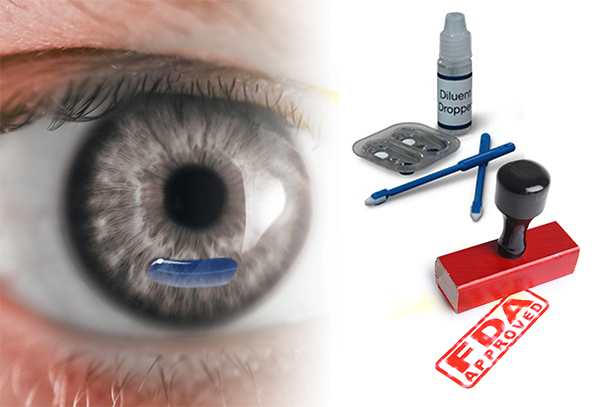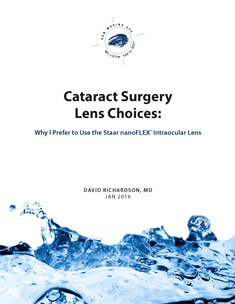In an earlier post I discussed the evidence that sutureless cataract surgery could leave the eye at risk for developing infection. Up until this week the only alternative to leaving the corneal incision as-is was to place a suture. Unfortunately, suturing takes additional time, adds cost, and can occasionally result in minor irritation or astigmatism. Thus, most surgeons do not bother with it (though I routinely place a suture at the end of my cataract surgeries).
Ironically, many surgeons even market sutureless cataract surgery as somehow advantageous to the patient – which I find frankly disingenuous. How can leaving an incision open to increased risk of bacterial entry (and vision-threatening infection) be beneficial to the patient? There may now be an opportunity for marketing hype to match real benefit to the patient with regard to closing the cataract surgery incision. Recently the FDA approved the use of ReSure® Sealant to prevent leakage from the cataract surgery incision. This is the first sealant to be approved by the FDA for eye surgery.
The study data presented to the FDA was impressive. Incisions closed with the ReSure® Sealant leaked less than 5% of the time. This compares very favorably to the “gold standard” of incision closure (suturing) after which the incision was noted to leak 35% of the time. Although I was surprised by the high percentage of leakage associated with suture closure in this study, I am excited about the availability of a new, seemingly more effective, and faster alternative to placing a suture at the end of cataract surgery.
Alas, one critical piece of information has yet to be disclosed by Ocular Therapeutix (the maker of ReSure® Sealant): the price. As is commonly known, one can only expect two out of the following three: cheap, fast, and good. As the ReSure® Sealant appears to be both fast and good, we can expect it won’t be cheap. Unfortunately, adding an expense to cataract surgery when surgery center reimbursement from insurance is anticipated to drop will be a tough sell with surgery center owners and administrators.
I don’t want to suggest that surgery center administrators are just being miserly here. As much as I would like to use the ReSure® Sealant on my patients, I have to admit that the cost might just be too prohibitive to be practical. The entire point of sealing the incision is to prevent bacteria from entering the eye. Bacteria cause infection (endophthalmitis) which can result in loss of vision or even blindness. The current rate of endophthalmitis in the USA ranges from 1 in 500 to 1 in 2,000. Let’s use 1 in 1,000 as an example. If the ReSure® Sealant were to half the rate of endophthalmitis a surgery center would have to use it on 2,000 patients in order to prevent one additional infection.
No one yet knows what the ReSure® Sealant will cost as Ocular Therapeutix has not disclosed pricing yet. Let’s assume, however, that bulk pricing is $50 per package (which is about 50% off the single-package pricing I’ve heard bandied about). The cost to the surgery center to prevent one additional infection would then be $50 x 2,000 = $100,000! That’s an expensive pill to ask a surgery center to swallow when Medicare and insurance will not reimburse the center any extra for using a more advanced or effective method of wound closure.
Hopefully Ocular Therapeutix will price the ReSure® Sealant well below what I’ve modeled above (though I wouldn’t bet on it). As a surgeon I’d love to have it available for my patients and I will be advocating for its use within the center in which I operate. If I’m given the opportunity to try it out I’ll update this blog with my experience.










Thanks for information. Can it also be used in vitrectomies, and what about EU approval ?
I don’t know about EU approval. Here in the USA the FDA has approved it only for use in cataract surgery – though retina surgeons could use it “off label”. It will be interesting to see who actually uses it. I was informed earlier today that one surgery center was quoted $95 per single-use package of the sealant. As I stated in the post, at even half that cost it’s going to be a tough sell. Personally, as much as I’d like to use this sealant I don’t think there’s much of a market for it (at least not at… Read more »
As a patient, I’d be more concerned about improving my outcome, rather than the surgery center costs. The real question is how much out-of-pocket you would charge to reduce my risk of infection.
I share that concern with you. it’s one of the reasons I’d like to try out the ReSure sealant. Unfortunately, Medicare has what is called the “golden scalpel rule.” In short, this rule states that whether a surgeon uses a scalpel made of steel, gold, titanium, or light (such as a laser) Medicare is going to pay the surgery center (as well as the surgeon) the same fee. In addition, Medicare prohibits billing patients for the extra cost of more expensive equipment or supplies used in cataract surgery. The only exception to this is when a patient chooses to have… Read more »
I am NOT asking the surgery center to take up the cost slack. I am asking how much would you charge me for the ReSure Sealant if I decide that I want it.
No, you may not be asking that a surgery center take up the “cost slack”, but the government and most commercial insurances are. Please re-read my reply to your initial post. Doctors in the USA who participate with Medicare and most commercial insurances are not allowed to charge their patients additional fees for anything that falls under the “golden scalpel” rule. Frustrating? Absolutely! Consumers are able to “upgrade” everything from their cells phones to car interiors. Yet our government has decided that you have no right to do so with your own body! Fortunately, there are doctors who refuse to… Read more »
Thanks for the clarification. I couldn’t find any mention of the “golden scalpel” in your book, purchased from Amazon a few months ago. A great source of information, by the way, in my Kindle library! Does laser surgery also fall under this rule?
I’m glad you found my book informative. I didn’t mention the “golden scalpel” rule in it because I didn’t think most non-surgeons would care and until recently this has not been a big issue. Now, however, with femto laser-assisted cataract surgery and tissue adhesives such as the ReSure sealant, the golden scalpel rule may be an issue patients should be aware of. In general, this rule does make sense. Let’s take an example outside of medicine. I don’t particularly care whether my accountant uses a $0.20 Bic pen, $200 Montblanc, or $2,000 laptop to balance my books and prepare my… Read more »
I agree with Nelson. Pass the charge on to patient who wants less risk of infection.
It is a medical cost and some insurances might pay.